Contradictory economic data and uncertainty on interest rates put downward pressure on most indexes. Investors appeared to be adjusting their interest rate expectations as each new morsel of U.S. data was released. Only the All Ordinaries, Hang Seng, Kospi and Bolsa were up on the week. The U.S. dollar rebounded against the yen, euro and pound sterling after expectations for a rate cut were put on hold after Friday's employment data and ISM non-manufacturing report. Crude prices climbed on political woes in Nigeria, a major supplier.
For the record
October ended with a positive note as 12 of the 13 indexes followed here up on the month. Only the Kospi declined - by 0.5 percent. Three indexes, the STI, S&P/TSX composite and the Bolsa, ended the month with gains at or over 5 percent. They were up 5.2 percent, 5 percent and 5.1 percent respectively. In the 4 percent range were the Nasdaq, All Ordinaries, Hang Seng and DAX. The Dow gained 3.4 percent while the FTSE gained 2.8 percent. The least strong were the two Japanese indexes - the Nikkei up 1.7 percent and the Topix up 0.4 percent.
Global Stock Market Recap

Europe and the UK
After a better-than-expected U.S. employment report and an improved ISM non-manufacturing report, stocks in Europe turned positive Friday after a negative week. They were also helped by favorable insurance company earnings reports. The FTSE was virtually unchanged however. Consumer goods companies that are dependent on U.S. sales such as DaimlerChrysler and Royal Philips Electronics benefited from the reports. But even though the CAC and DAX were positive Friday, they were down on the week as was the FTSE. Earlier, shares were lower as markets succumbed to a bout of profit taking and mixed earnings reports from companies such as Unilever and BASF. And an indication that the ECB will increase their key interest rate when they meet in December undermined stocks further.

European Central Bank waits until December
Using the code words 'strong vigilance' ECB President Jean Claude Trichet virtually guaranteed that the European Central Bank will increase interest rates on December 7th, the next scheduled Governing Council monetary policy meeting. The ECB left its policy interest rate at 3.25 percent on Thursday. At his monthly press conference following the meeting, President Jean Claude Trichet used the key phrase 'strong vigilance' in describing the Governing Council's posture towards price stability risks. That phrase has been used in the past to indicate that a rate increase would be forthcoming at the next meeting. The ECB last increased rates at its October meeting. Although October's reading of the flash harmonized index of consumer prices was below the ECB's 2 percent ceiling for a second month, Trichet said that inflationary pressures were on the upside. The latest HICP reading was influenced disproportionately by dropping gasoline prices.

Asia/Pacific
Asian/Pacific indexes followed here were evenly split between winners and losers last week. While both the Hang Seng and All Ordinaries hit new highs and the Kospi finally climbed above its 2006 year-end level, the two Japanese indexes and the STI were down on the week. Asian markets, which were closed when Friday's U.S. economic reports were released, will have the weekend to decide how to react.
The Hang Seng was up on U.S. interest rate expectations. Investors opined that a slowdown in U.S. manufacturing, indicated by a soft ISM manufacturing report at mid-week, would keep global interest rates from rising. As a result banking and real estate developers led the charge upward. Lower rates would help cut developers' project costs in the immediate future. The Hong Kong dollar is pegged to the U.S. dollar, and interest rate increases in the U.S. are immediately passed on by the Hong Kong Monetary Authority.

The All Ordinaries continued to forge new ground as it climbs to ever new highs. This is despite a softening in Australia's overall economic performance and the likelihood of an interest rate increase as soon as this week. With inflation well over the Reserve Bank of Australia's inflation range (third quarter CPI was up 3.9 percent on the year), investors were undeterred and continued to pile into commodity and mining stocks.

Bank of Japan
While the Bank of Japan left its policy interest rate at 0.25 percent last week, it heightened expectations that it is preparing to increase interest rates. The Bank provided an optimistic assessment of the economic outlook along with a warning that current low rates could increase swings in the economy. In its report, the BoJ said it anticipates that inflation will accelerate in the next fiscal year that begins on April 1, 2007. The report voiced concern that prolonging a low-rate policy could cause "large economic swings," namely excessive economic growth and corporate investment. The bank reiterated that it would be guided by economic and price developments. They emphasized that they would eventually increase rates, but they would remain at low levels "for some time."

BoJ Governor Toshihiko Fukui, in a press conference following the report, kept the door open for a second interest-rate increase this year. He said he had not changed his view that he cannot rule out the possibility of another rate increase in 2006. He reiterated that the bank has no predetermined time for an interest-rate increase. Further he said that rate decisions will be made "not too late, not too early, but at an appropriate time."
Currencies
Both the yen and euro were down last week. The two currencies dropped on Friday after favorable U.S. data indicated the Federal Reserve would not reduce interest rates in the near future as so many in the market had assumed. The dollar had been weakening on the presumption that the Fed might have to cut interest rates to resuscitate the U.S. economy after weaker-than-expected data were released earlier in the week. However, traders did a u-turn Friday morning after the unemployment rate dropped to a 5-year low and the ISM data showed improvement. Now the concern is with inflationary pressures emanating from the tight labor market.

Indicator scoreboard
EMU - October flash harmonized index of consumer prices was up 0.1 percent and 1.6 percent when compared with last year. This was the second month that the HICP was below the ECB inflation ceiling of 2 percent. Most of the moderation was due to lower gasoline prices. As with all flash estimates, no detail was available.

October manufacturing purchasing managers' index edged up to 57.0 from 56.6 in September. The index was up in France, Italy and Spain, but inched down in Germany. Both the input and output price components were down on the month. Industry output and new orders components were at three-month highs.

September unemployment rate remained at 7.8 percent for the second month. The lowest rates were in Denmark, the Netherlands, Ireland and Austria. Germany and France had the highest rates in the EMU.

EU - October economic sentiment climbed to 110.3 from 109.3 in September. Consumer sentiment was unchanged at minus 8 while industrial confidence edged up to a reading of 5 from 4 in September. Services sentiment improved to 21 from 18 while retail sentiment climbed to 4 from 3 in the previous month.

Germany - September retail sales excluding autos and gasoline stations sank 1.7 percent and were down 1.2 percent when compared with last year. This was the largest drop in over two year. Total sales were down 0.8 percent and up 0.9 percent on the year. Sales of household appliances, furniture and building material climbed 4.9 percent on the year as consumers purchase durables prior to the 3 percent increase in the value added tax (VAT) slated for January 1, 2007. The rate will increase from 16 percent to 19 percent.

October seasonally adjusted unemployment dropped by 67,000, pushing the unemployment rate down to 10.4 percent from 10.6 percent in September. Most of the decline was in West Germany where unemployment declined by 56,000. September payroll employment was up by 24,000.

France - September unemployment rate dropped to 8.8 percent from 9 percent in August. The number of jobless as measured by the International Labour Organisation's measure declined by 50,000. The number of unemployed is at a 55-month low.

Asia
Japan - September seasonally adjusted industrial production dropped 0.7 percent but was up 4.8 percent when compared with last year. Output for transport equipment, general machinery and electrical machinery declined. Inventories were up 1 percent and 0.9 percent on the year. But shipments dropped 2.6 percent and were up 4.5 percent on the year.

September unemployment rate edged up to 4.2 percent from 4.1 percent in August. The jobs-to-applicants ratio, which shows how many positions are on offer to a seeker, was 1.08 as 110,000 people left the job market. For every 100 job applicants in September there were only 64 full-time positions available, down from 65 in January. Part-time and temporary positions were available at more than twice those rates.
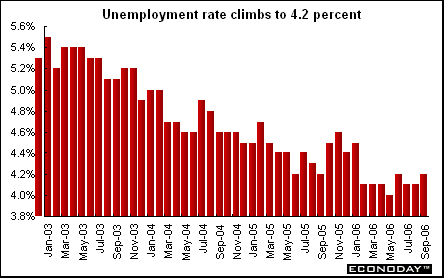
Australia - September retail sales were up 0.1 percent and 5.9 percent when compared with last year. Of all major categories, only clothing was up on the month.

September merchandise trade deficit was A$646 million, about double the deficit in August. Exports were down 1.5 percent while imports edged up 0.3 percent. A severe drought has negatively affected exports.

Americas
Canada - September industrial product price index (IPPI) dropped 1.6 percent and was up 1.3 percent when compared with the same month a year ago. Lower prices for petroleum products were the major contributors to the monthly decrease. Petroleum and coal products prices decreased by 13.8 percent as the cost for crude oil declined for a second month. This was the largest monthly decline since the 13.6 percent drop in April 2003. If petroleum and coal product prices had been excluded, the IPPI would have remained unchanged rather than falling 1.6 percent.
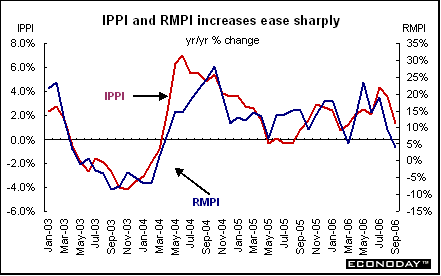
September raw materials price index (RMPI) was down 5.2 percent and was up 4 percent when compared with last year. Mineral fuels were the major contributor to the monthly drop, with prices declining 9.9 percent compared to August. Prices for crude oil were down 11.6 percent mainly due to higher inventories as well as softening demand. If mineral fuels had been excluded, the RMPI would have been unchanged from August instead of falling 5.2 percent.
The Canadian dollar was up 0.2 percent against its U.S. counterpart. As a result, the total IPPI excluding the effect of the exchange would have fallen 1.5 percent instead of its actual decrease of 1.6 percent. On a 12-month basis, the value of the Canadian dollar rose 5.5 percent against the U.S. dollar. If the impact of the exchange rate had been excluded, producer prices would have risen 2.8 percent between September 2005 and September 2006, rather than their actual increase of 1.3 percent.
August gross domestic product was up 0.3 percent and was up 2.2 percent when compared with the same month a year ago. The service sector was up 0.4 percent and 3.3 percent on the year while the manufacturing sector was virtually unchanged on the month and down 1.3 percent on the year. Both utilities and construction declined. Energy gained 0.7 percent mainly on increased natural gas production and transportation.
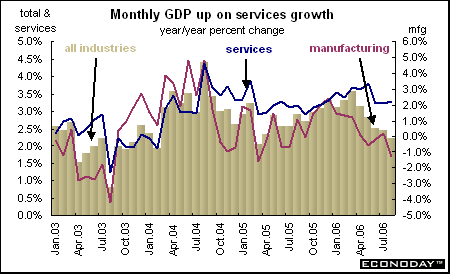
October employment jumped by 50,500 jobs sending the unemployment rate down to 6.2 percent from 6.4 percent in September. Employment for the 10 months of 2006 has gained 261,000 jobs. October full-time employment was up by 68,000 and 259,000 this year. Most of the employment growth took place in the western provinces of Alberta and Saskatchewan. However, manufacturing employment was down 15,200.
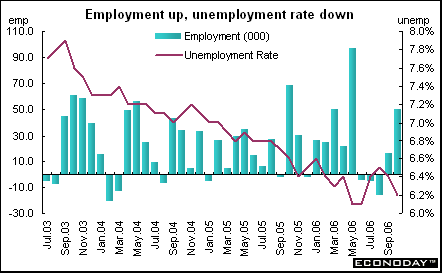
Bottom line
Last week was marked by both Bank of Japan and European Central Bank meetings. While the Bank of Japan said that prices are expected to continue to increase and they would increase interest rates eventually, the ECB president used his code words 'strong vigilance', virtually ensuring an increase at their December meeting. In Europe, economic news was basically positive while in the U.S. the data were mixed.
This week includes meetings by the Reserve Bank of Australia and the Bank of England. Analysts think it is likely that both banks will increase interest rates by 25 basis points to 6.25 percent and 5 percent respectively. Analysts will continue to mull the U.S. employment report and perhaps revise their outlook for the fourth quarter.
Looking Ahead: November 6 through November 10, 2006
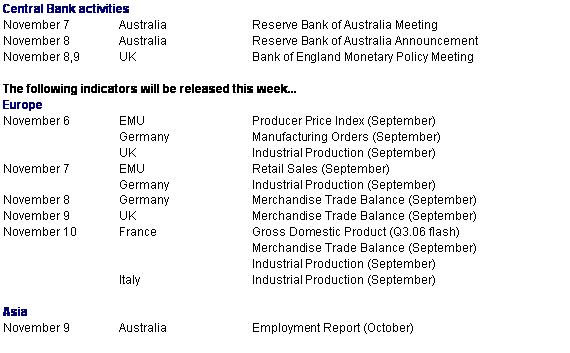
Anne D Picker is the author of International Indicators and Central Banks, which will be published by John Wiley and Sons in January 2007.

